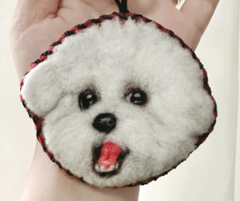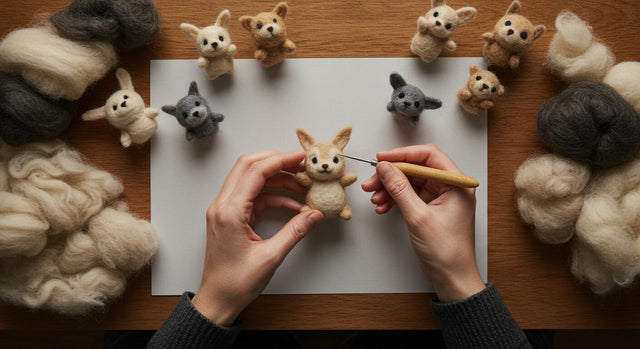What is needle felting and why is it fun
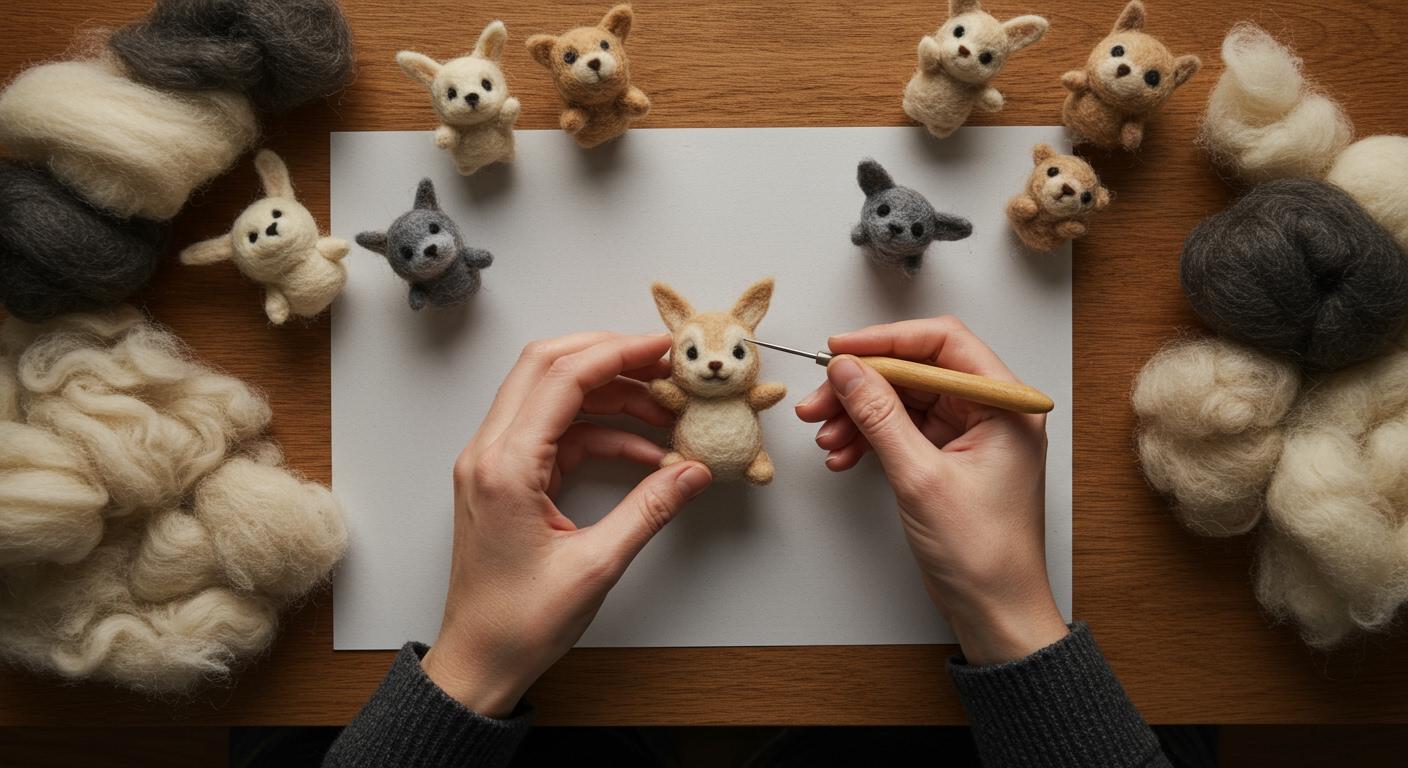
Needle felting is a craft. You use a special needle to shape soft wool. You can make figures, animals, or designs. You watch fluffy wool change with every poke. Each poke helps make something unique. Studies show handmade creative activities help you relax. Felting can help you feel calm. The gentle motion of the needle is soothing. The feel of natural wool is nice. It can be very relaxing.
You might forget your worries for a while. You enjoy the gentle rhythm. You feel proud when your creation comes to life.
Key Takeaways
Needle felting is a fun craft. You use wool and a special needle. You can make cool figures and designs.
This craft helps you relax and feel calm. It can help you forget your worries. You focus on poking the wool. The rhythm is soothing.
You can show your creativity in many ways. You can try different colors and shapes. You do not need strict patterns or templates.
Being part of a needle felting group is great. You get support and ideas from others. You feel like you belong.
Beginner kits help you start needle felting easily. You can enjoy making things right away. You can be proud of your creations.
Needle Felting Basics
What is Needle Felting?
Needle felting is a hands-on craft. You use special needles to poke and shape wool into figures, animals, or designs. The wool fibers tangle and stick together as you work. You can create soft sculptures, flat pictures, or even tiny ornaments. Needle felting basics are easy to learn. You start with loose wool and watch it transform with each poke. This craft lets you explore different techniques and styles. You can make simple shapes or detailed models. Felting gives you a way to turn fluffy wool into something solid and unique.
Tools and Materials
You need a few supplies to get started with needle felting. The right tools make the felting process smoother and safer. Here’s a quick look at what you’ll use:
Tool |
Features |
|---|---|
Clover’s Mat Cleaner & Claw |
Releases fibers from the mat, holds fibers in place, protects fingers, blends colors. |
Wool Carder Brushes |
Breaks up wool fibers, blends colors, creates wool-like textures from yarn. |
Cookie Cutters |
Shapes wool quickly, helps you make neat designs. |
Stencils |
Adds details, helps with precision in design. |
Wool Roving |
100% wool blends best; synthetic fibers don’t felt as well. |
You also need felting needles. Each type works best for different projects:
Coarse needle: Fast matting, good for big pieces.
Medium needle: Balances speed and detail, great for mid-sized projects.
Fine needle: Makes tiny details, perfect for delicate work.
Precision needles: Refines the surface, used at the end.
Wool is the main material. You’ll see wool tops, which are ropes of brushed fiber. True tops have fibers flowing in one direction. Commercial tops look messier. Handling wool tops the right way helps your felting turn out well.
Here’s a quick guide to wool types:
Wool Type |
Properties |
|---|---|
Merino Wool |
Fine, soft fibers; felts evenly; best for small details; not ideal for big projects. |
Corriedale Wool |
Medium-coarse; felts quickly; strong base; good for texture and durability. |
You can find kits that include all the supplies you need. Kits often come with wool, needles, and safety gear. Some kits even have finger protectors or needle holders to keep you safe.
Tip: Always use a leather glove or finger protector on your off hand. Felting needles are sharp, so pay close attention while you work.
How It Works
Needle felting uses special needles with notches along the shaft. These notches grab and tangle the wool fibers as you poke. The fibers lock together and form a solid mass. You shape and compress the wool by poking in the direction you want. It feels a bit like squishing clay into shape.
Felting needles are different from sewing needles or pins: instead of being smooth to pierce through fabric, they have notches cut along their shafts. Those rough notches snag, catch and push fibers they’re poked into, causing them to tangle with their neighbors enough to mat into a mass that has density and form: the nonwoven textile we know as ‘felt.’
You can use different techniques to get the look you want. Some people use cookie cutters or stencils for shapes. Others blend colors with brushes. The felting process can be quick or slow, depending on your project. Kits help you get started with the right tools and supplies.
So to use a felting needle by hand, you need to poke in the direction that you want to shape and compress, almost like squishing clay into shape.
Needle felting is simple to start. You just need wool, needles, and a few basic supplies. You can try different techniques and see what works best for you.
Why Needle Felting is Fun
Creative Expression
Needle felting gives you a chance to explore your imagination. You start with soft wool and a needle, then watch your ideas come to life. You can make animals, shapes, or even tiny scenes. The process lets you change your design as you work. If you poke the wool in a new direction, you see a new shape appear. You get to experiment with colors and textures. You don’t need to follow strict patterns. You can create something that shows your personality.
You can mix colors to make new shades.
You can blend wool to get different textures.
You can make flat pictures or 3D figures.
Artists and hobbyists say needle felting offers huge creative freedom. You get to express yourself and try new ideas. Each project feels like a new adventure. You don’t have to stick to templates. You can make something that tells your story.
The more you work with wool, the more you learn how it reacts. You adjust your technique and see your skills grow. Felting helps you reflect and adapt, which makes your creations even more special.
Relaxation and Stress Relief
Felting is calming. You focus on the gentle motion of the needle. The rhythm helps you relax. Many people say felting feels like meditation. You get absorbed in the craft and forget your worries. The soft wool feels nice in your hands. You watch your project take shape, and that brings satisfaction.
Research shows that creative activities like needle felting help lower stress and anxiety. When you work on a project, you enter a state called "flow." You lose track of time and feel peaceful. Some people say felting is their sanctuary during tough times. They zone out and focus only on their art. This helps them feel better and more balanced.
If you need a break from your busy day, try felting. You might find yourself feeling calmer and happier.
Accomplishment and Community
You feel proud when you finish a felting project. You see your hard work turn into something real. You can display your creation or give it as a gift. The sense of accomplishment boosts your confidence. Felting is not just about making things; it’s about growing your skills and seeing progress.
Needle felting also connects you with others. There are online groups and local clubs where people share their projects. Beginners get support and advice. You can ask questions, show your work, and learn from others. These communities help you feel like you belong. You make friends who enjoy the same craft. Sharing your felting journey makes the experience even more rewarding.
You don’t have to work alone. Join a felting group and celebrate your creativity together.
Needle Felting Projects
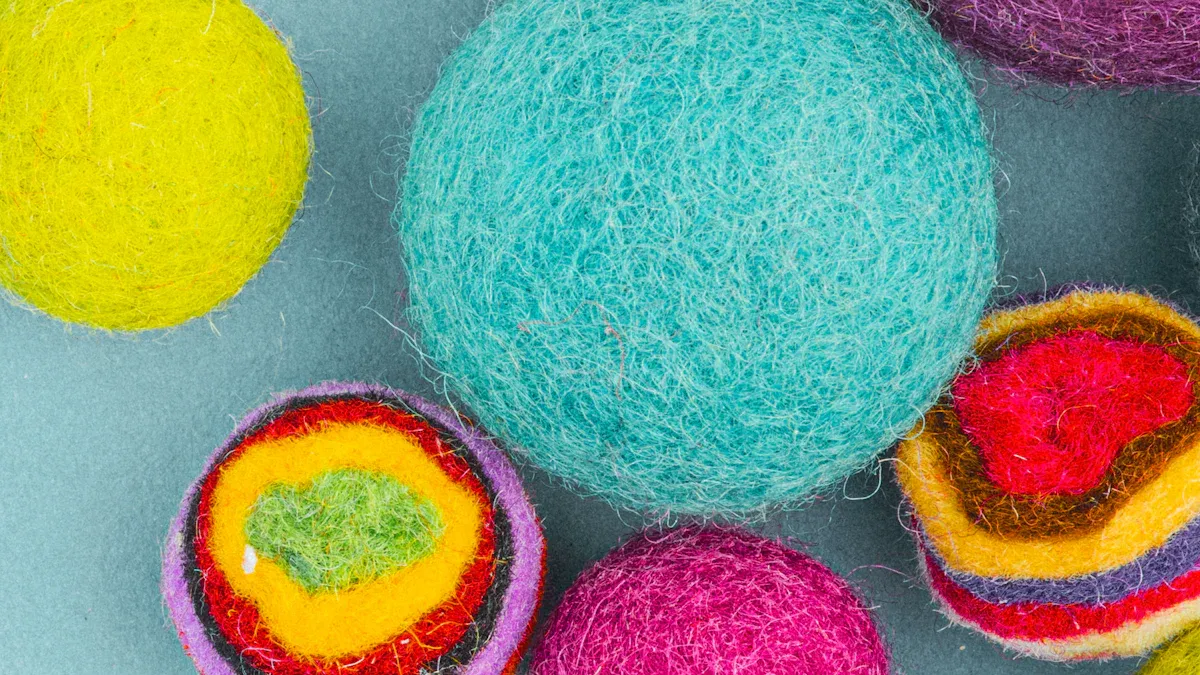
Beginner Project Ideas
You can begin with easy shapes and figures. Many people like making small animals or ornaments. You could try making a snowman, sheep, pumpkin, penguin, or chickens. These projects teach you how wool moves and how to shape it. If you want something fast, make a needle felted ball. It only takes a few minutes. Bumble bee brooches, spring bunnies, and mushrooms are fun too. These small crafts help you learn basic skills and feel more confident.
If you want a special project, look at Pawimprint’s Pet Portrait Custom Frame. This piece is made by hand using artisan felting. You pick the frame’s size, color, style, and background. Skilled artists use natural wool felt and strong wood for each portrait. The frame can have a custom engraving. Many people give these as gifts. They show the love between pets and owners.
Feature |
Description |
|---|---|
Artisanal Craftsmanship |
Made by hand with needle felting by skilled artists. |
Premium Materials |
Uses natural wool felt and strong wood for the frame. |
Customization Options |
|
Emotional Significance |
A special keepsake for people who love pets. |
Unique Artistic Expression |
Each portrait is different and special. |
Tips for Success
You can make felting easier by following some tips. Always use a cushion to protect your hands and your work. Try short, quick pokes with your needle, not deep ones. Start with a Star 36 needle for most projects. Choose medium softness wool like Corriedale or Shetland. This makes felting smoother and easier.
Picking the right wool is important for needle felting. Different types change how easy it is and how your project looks. Beginners should try a few kinds to see what they like. Jacob, Shetland, and Swaledale are good choices.
Don’t use Superwash wool. Keep your needle straight so it doesn’t break. Practice with animal shapes and ornaments to learn how to add details and make things even. These projects help you try new ideas and get better.
Project Type |
Time Required |
|---|---|
Basic Projects |
|
Small Decorations |
10-20 minutes to 1 hour |
Simple Animal Figures |
3-8 hours |
Realistic Animal Sculptures |
15-70 hours |
People who know needle felting suggest using medium softness wool. It works well for simple and detailed projects. Carded wool helps you felt faster and makes things smoother. Corriedale and Shetland are great picks because of their medium softness and safe practices.
If you mess up, it’s okay. Every project helps you learn and improve. Needle felting is a fun way to show your ideas and make something you can be proud of.
Start Needle Felting
Steps for Beginners
If you’re an absolute beginner, you’ll be happy to know that needle felting is easy to start. You don’t need fancy equipment or years of experience. Most beginner kits come with everything you need, so you can jump right in. Here’s a simple guide to help you begin your first project:
Roll a small bundle of carded wool into a tight oval. Tuck the ends as you roll.
If the wool loosens, unroll and start again. Keep the roll compact.
Squeeze the bundle gently. It should spring back if it’s firm enough.
Use short, controlled pokes with your felting needle. Rotate the wool often to keep the shape even.
Add small amounts of wool where needed and repeat the process.
Use a paper template as a size guide if you want.
You only need a few supplies and steps to get started. Felting needles, wool roving, and a felting surface are the basics. Take a look at how needle felting compares to other crafts:
Craft |
Initial Supplies Needed |
Estimated Cost |
|---|---|---|
Needle Felting |
Felting needles, wool roving, felting surface |
|
Knitting or Crochet |
Needles or hooks, yarn, notions |
$30 – $60 |
Card Making or Scrapbooking |
Paper, embellishments, adhesive, stamps, ink |
$50 – $100 |
Jewelry Making |
Beads, wire, pliers, wire cutter, findings |
$50 – $150 |
Painting |
Brushes, paints, canvas or paper, palette, mediums |
$60 – $250 |
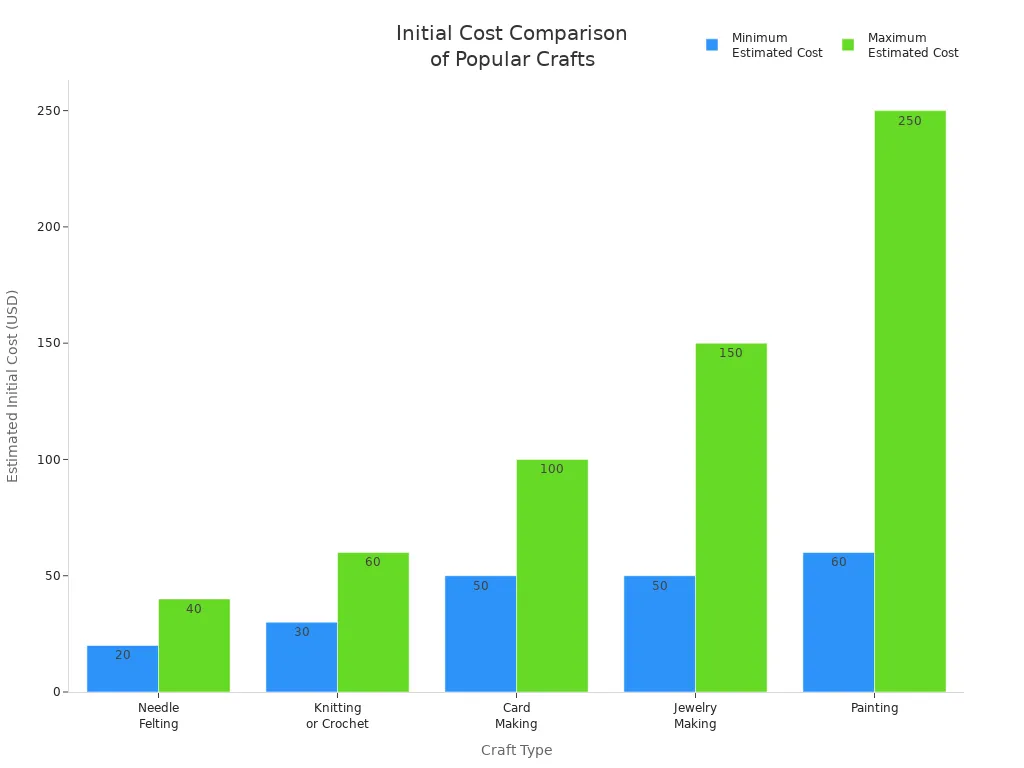
Enjoying the Process
You’ll find that felting is relaxing and fun. Many beginners say the repetitive motion helps them feel calm. You can work almost anywhere, and you don’t need much space. Here’s what makes needle felting enjoyable:
It’s a great stress reliever. The gentle poking feels soothing.
You get to be creative. You can make animals, shapes, or gifts.
It’s affordable. You only need a few basic tools.
You can take your project anywhere. Felting is portable.
Handmade gifts are special. People love receiving something you made.
Beginners often find needle felting to be a rewarding and meditative experience, emphasizing the satisfaction of creating tangible results and the importance of technique.
If you want to keep going, try working in short sessions. Keep your supplies visible so you remember to craft. Celebrate each finished project, no matter how small. Online tutorials and workshops can help you learn new techniques and connect with others. You’ll discover that the journey matters just as much as the finished piece.
Needle felting stands out as a fun and rewarding craft for many reasons:
You can start easily with beginner kits.
The process feels calming and helps you relax.
You get to show your creativity with colors and textures.
You see quick results and feel proud of your work.
Craft Type |
Skill Level |
Cost |
|---|---|---|
Needle Felting |
Intermediate |
If you want a special project, try making a Pawimprint Pet Portrait Custom Frame. You create something personal and meaningful that you can treasure for years.
FAQ
What is the best wool for needle felting?
You want wool that felts easily. Corriedale and Shetland work great for beginners. Merino wool feels soft and smooth. Avoid Superwash wool because it does not felt well.
What tools do you need to start needle felting?
You need felting needles, wool, and a felting mat or cushion. Some people use finger protectors for safety. Kits often include everything you need to begin.
What makes needle felting different from wet felting?
Needle felting uses dry wool and special barbed needles. Wet felting uses water and soap to mat the fibers. You can shape more details with needle felting.
What projects can you make with needle felting?
You can make animals, ornaments, brooches, or even custom pet portraits. Many people start with simple shapes like balls or hearts. The possibilities feel endless!
What should you do if your needle breaks?
Stay calm. Needles can break sometimes. Always keep extra needles nearby. Use slow, straight pokes to help prevent breakage.
